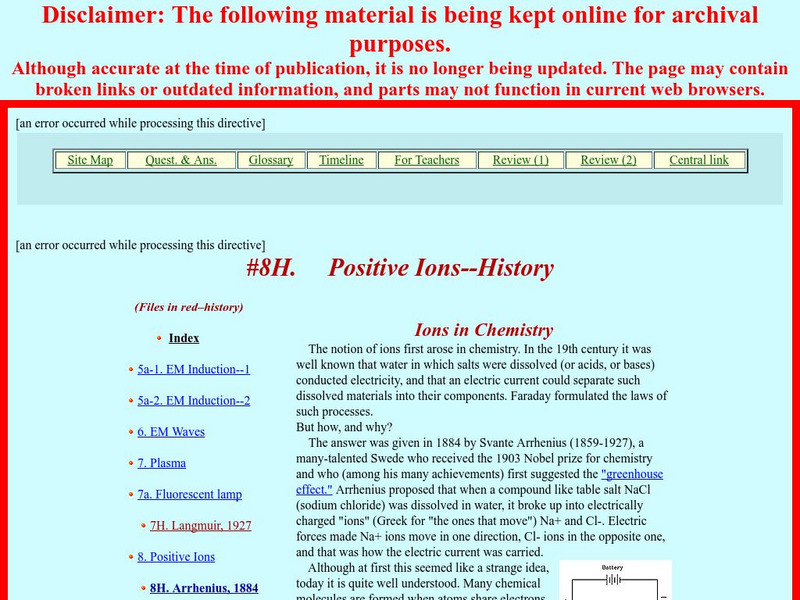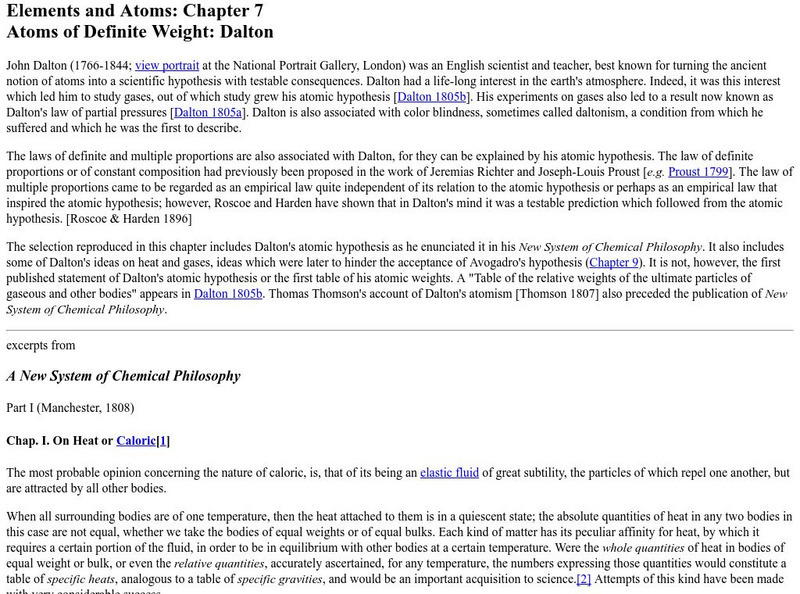PBS
Pbs Learning Media: Atomic Structure
Take a look at the parts of an atom and learn about its properties.
NASA
Nasa: Positive Ions History
As the title suggests, this page from NASA goes over the history of man's study of positive ions. How did we come to know what we now know about cations?
E-learning for Kids
E Learning for Kids: Science: Norway: What Is Matter Made Of?
Set sail with Oleif, the Viking. Make his boat move by learning all about matter and particles.
University of Southern California
Atomic Bonds
This slide show on atomic bonds contains several slides on electron affinity. Other topics include covalent, Sigma and Pi bonds, and atomic bonding in solids.
TED Talks
Ted: Ted Ed: Just How Small Is an Atom
Fast-paced animation uses impressive metaphors to give an intuitive sense of just how small atoms are and what's inside them. [5:28]
Towson University
Towson University: Online Writing Support: Prepositions
This entry focuses on prepositions, prepositional phrases, and particles including defining and providing examples of each. It also offers an explanation of the difference between prepositions and particles and lists of common...
Science Buddies
Science Buddies: Porosity
Soils are made of particles of different types and sizes. The space between particles is called pore space. Pore space determines the amount of water that a given volume of soil can hold. Porosity is the percentage of the total volume of...
Simon Fraser University
Chem1 Virtual Textbook: The Language of Light
Acting as a subtopic of the General Chemistry Virtual Textbook's section on Atoms and the Periodic Table, this site discusses light in relation to particles and waves. The difference between particles and waves is addressed along with...
Simon Fraser University
Chem1 Virtual Textbook: Molecules in Motion
As part of the General Chemistry Virtual Textbook, this site continues a study conducted on various topics related to gases. As a specific topic, the site covers an introduction to kinetic molecular theory.
Ohio State University
Ohio State University: Electron Affinity
This page describes electron affinity and the periodic trends of the elements according to their positions on the periodic table.
Museum of Science
The Atom's Family: Radiometer
Help Dracula find out about light waves by using a virtual radiometer.
Purdue University
Purdue Univ: Gases, Liquids, and Solids
This site has a brief description of the differences in particles in a gas, liquid, and solid. Animated microscopic pictures demonstrate the molecular movement in each state. Information is then summarized in an easy-to-read chart.
Symmetry Magazine
Symmetry Magazine: Explain It in 60 Seconds: Quarks
Quarks, described here, are particles of matter that cannot be further broken down. Thus they are called fundamental particles. "Explain It In 60 Seconds" is an article series that aims to summarize in a few paragraphs the meaning of...
Symmetry Magazine
Symmetry Magazine: Explain It in 60 Seconds: Particle Event
Particle events, described in this article, are events that can be observed with a particle detector. "Explain It In 60 Seconds" is an article series that aims to summarize in a few paragraphs the meaning of different concepts in...
Symmetry Magazine
Symmetry Magazine: Explain It in 60 Seconds: Jets
Jets, described in this article, are particle sprays resulting from other particles colliding at high speeds, such as can happen in particle accelerators. "Explain It In 60 Seconds" is an article series that aims to summarize in a few...
Symmetry Magazine
Symmetry Magazine: Explain It in 60 Seconds: W Boson
The W boson, described here, is important in the study of the differences between matter and antimatter. "Explain It In 60 Seconds" is an article series that aims to summarize in a few paragraphs the meaning of different concepts in...
Symmetry Magazine
Symmetry Magazine: Explain It in 60 Seconds: Rare Particle Decays
Rare particle decays, described here, are events that could lead to insights into the unknown processes of the universe. Scientists hope to learn more about them through research with particle accelerators. "Explain It In 60 Seconds" is...
Symmetry Magazine
Symmetry Magazine: Explain It in 60 Seconds: Z Boson
The Z boson, described here, is important in the study of electroweak force. "Explain It In 60 Seconds" is an article series that aims to summarize in a few paragraphs the meaning of different concepts in particle physics.
Symmetry Magazine
Symmetry Magazine: Explain It in 60 Seconds: Neutrino Masses
Neutrinos, described here, are particles scientists still have a lot to learn about. They are trying to measure their masses. "Explain It In 60 Seconds" is an article series that aims to summarize in a few paragraphs the meaning of...
Symmetry Magazine
Symmetry Magazine: Explain It in 60 Seconds: Virtual Particles
Virtual particles, described here, are particles that appear and disappear so rapidly they can be detected only by their effect on other particles. "Explain It In 60 Seconds" is an article series that aims to summarize in a few...
Symmetry Magazine
Symmetry Magazine: Explain It in 60 Seconds: Cherenkov Light
Cherenkov light is explained here as the light emitted when a charged particle travels through matter faster than light would be able to. This would be slower, however, than the maximum speed of light, which occurs in a vacuum. "Explain...
Other
University of Sheffield: Bubble Chambers
A description of the advantages and disadvantages of bubble chambers. Links to more advanced physics and formulas.
Other
Le Moyne University: John Dalton
This site from the Le Moyne University provides excerpts from Dalton's "A New System of Chemical Philosophy" published in 1808. Includes Dalton's table of atomic weights and and scanned atomic symbols.
Quia
Quia: Common Type Ii Cations
This page links to a number of Java games that are designed to make learning the names, symbols and charges of the various cations fun.














